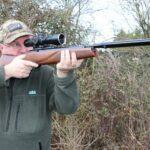
Q: I am an avid reader of Bowhunter Magazine, and I look forward to each issue and the information and hunting stories you and the other writers contribute! I am planning an elk hunt in Montana with my brother, nephew, and close friend. Could you make some recommendations on arrow/broadhead choices for the hunt? Scott Cool, via e-mail
A: Thanks for your e-mail. First, let’s establish the number-one goal of every elk hunter — a bilateral pneumothorax — otherwise known as a double-lung collapse. If you only puncture one lung on an elk, the odds of recovery are close to zero. That makes maximum, and hopefully two-hole, penetration more important than on just about any other North American big game animal.
There are many factors to consider: draw weight/length, arrow speed/weight (both kinetic energy and momentum), and broadhead construction. All of these factors are intertwined in their importance. If you shoot low poundage, or a short draw length, your arrow speed will be adversely affected, necessitating a heavier arrow and a broadhead designed for maximum penetration. Heavier draw weights and longer draw lengths make the other factors less critical, but they are still important.
Personally, I tend to vary my arrow weight according to the species I am hunting. I may want a flatter trajectory for antelope, deer, or caribou, but for a very tough animal like an elk, I prefer an arrow in the 500-grain range. I have a 30.5-inch draw, and I typically shoot 67 pounds. Because this setup delivers plenty of energy and momentum, I can shoot most any quality broadhead from fixed blades to heavily built mechanicals like the Rage Trypan and not worry about penetration.
We don’t have the space to get into all the physics, and there is plenty of dispute among bowhunters on this topic, but without knowing your specifics I would recommend an arrow weighing at least 450 grains (total arrow/broadhead) for elk. An arrow’s front of center (FOC) is also important to penetration, and I strive for at least 12 to 13 percent or more.
Yes, if your draw weight and arrow speed are exceptional (well over 300 fps), you might get by with a lighter, flatter arrow, but I still wouldn’t go below 400 grains under any circumstances. Will it work, yes, but if the shot is in any way marginal, a lighter arrow will not likely bail you out. If your draw weight and arrow speed is average (under 280 fps), your total arrow weight should go up. I know that sounds counterintuitive, but consider the recurve archer who is shooting only 190 to 200 fps and using arrows of 600 grains and up. They certainly don’t go down in arrow weight. In almost any scenario, a heavier arrow will penetrate better on a live animal. And no test medium can replicate the real thing.
Broadhead design does matter, but mostly in a basic sense. If you start with a well-tuned bow, there is no question the best penetrating broadhead is a cut-on-contact, fixed two-blade design like a Muzzy Phantom, Magnus Stinger, or Iron Will broadhead. A fixed-blade broadhead and certain mechanical heads are next, and then comes the really wide-cut mechanical broadheads. If you hope to drive a two-inch-wide broadhead completely through an elk, you had better have some energy and a heavy arrow behind it. If you do, it’s devastating.
By now, you can see that all these factors are codependent, which is why there is so much debate. If you’re an average archer shooting 65 pounds at a 28-inch draw, I would shoot an arrow/broadhead combo that weighs around 475 grains (with decent FOC), and a strong, super-sharp broadhead that gives you confidence. Then hunt your way close and drive it through both lungs. Good luck.











































